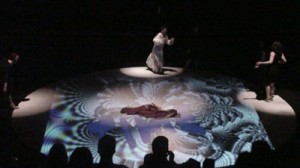 This musical creation – call it theater or call it opera – with its live dancing singers and singing dancers – one-person virtual orchestra with live guitar and psychedelic visual imagery projections on the floor, is an entirely new production, with a 2010-11 score, of Elodie Lauten‘s iconic, The Death of Don Juan, (originally conceived in 1981), with its present premiere showing at the Theater for the New City.
This musical creation – call it theater or call it opera – with its live dancing singers and singing dancers – one-person virtual orchestra with live guitar and psychedelic visual imagery projections on the floor, is an entirely new production, with a 2010-11 score, of Elodie Lauten‘s iconic, The Death of Don Juan, (originally conceived in 1981), with its present premiere showing at the Theater for the New City.
This is an amazing production of a compelling musical, visual and visceral work, with wonderful sound – magical – with Ms. Lauten controlling the Electronic Orchestra, and excellent performances by the cast and the production team.
Don Juan, the archetypal seducer, meets empowered women in this opera: to quote Ms. Lauten, there is “something compelling about Juan as a character: he has courage, passion, and above all, he is thoroughly human, because he is after love and freedom. Something about him resonates in us, both women and men, and we cannot bring ourselves to hate him.”
Don Juan dances and sings with empowered female spirits – reminisces of the women in his life – as performed by Douglas McDonnell as the title character, Don Juan, and Courtney Symonds as Death as a Woman, Arianna Armon as Death as a Lover, Mary Hurlbut as Death as a Spirit, and, Alisha Desai as Death as a Shadow. All give compelling performances, with varied and memorable singing, dancing and acting.
Elodie Lauten performs the synthesizer and Electronic Orchestra; and, Jonathan Hirschman, the electric guitar.
The music, libretto and visual imagery is by Elodie Lauten; it’s directed by Robert Lawson and Henry Akona; Alexander Bartenieff is the Lighting Designer; Ron Benjamin, the Audio Engineer; Robert Mendoza, the Stage Manager; Anna Thomford and Carla Gant, the Costume Designers; and, Elodie Lauten, Producer and Musical Director.
The theater is in NYC at 155 First Avenue, (10th Street), May 5 – 22, 2011. (Tickets $15 / $10 students & seniors; Thurs., Fri., Sat., 8pm; Sunday 3pm matinee; box office tel. 212-254-1109.)
Ms. Lauten’s program notes sketches out the whole opera, its theme, the libretto; and its creative process, employing both Western and Eastern methods. I need not repeat it. Ms. Lauten is a Parisian romantic post-minimalist composer, who lives and works in New York, and who is most imaginative in her craft and emotional focus – this is a brilliant and moving piece; most entertaining and thought-provoking.
Are we there yet? For years, we’ve been listening to virtual instruments, even virtual orchestras, but the sound samples and sounds produced were but distorted shadows of the acoustic instruments. This sound sounds real.
Ms. Lauten, by patient work and brilliance has gotten the sound right – and we’re finally there, with her one-woman keyboard controlling a virtual orchestra (with a live electric guitarist).
Furthermore, the imagery – psychedelic, to some extent, a child of the 1960s, but out of wellsprings of much older traditions, is convincing, powerful and beautiful in its imagery.
This is real opera, but it is also real theater; and, it is as powerful and accessible as a Broadway musical, even though it has a seriousness of purpose and attention to detail that is rare in either theater or operatic settings.
Real opera should be passionate – not tidy, but vary large emotions and small details, with enough changes and transformations to keep things interesting, and enough consistency to have a story to follow. Real opera, like real life, should be unpredictable, even when one sees things coming. Real opera should be real theater: there is no boundary line between musical theater and opera (although one has classically-trained singers and conventions, there is no need pigeon-hole one).
Are we there yet? Yes, thanks to Ms. Lauten, we’ve arrived at the point where electronic technology – virtual orchestra and imagery – has the realism and power to be real, vivid, and emotionally true.

Ummm. Did we see the same show? I swung by last week (largely due to the shout outs from Sequenza21 and chambermusiciantoday) and was entirely underwhelmed. The music included some lovely gestures, but was, well, minimal. The projected imagery looked like it was made with out of the box photoshop filters. And the singing was at best, competent, and in some cases, not even that. Several sections were very unintentionally microtonal. I’m talking high school musical bad.
I don’t begrudge Sequenza21 and chambermusiciantoday for promoting small independent works, nor do I regret seeing this, there were worthy moments, but for a review to claim brilliance? That this was as accessible as broadway? (My 69 year old father’s befuddled reaction was strong empirical evidence to the contrary.) That somehow THIS is the piece that resolves the opera/music theater divide? Come on. Let’s have a sense of journalistic perspective here.
Awesome. I wish I could see this. I’m familiar with The Death of Don Juan as an album of recorded music only, and I’d love to see this on-stage.